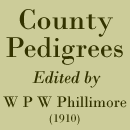Musters of Annesley
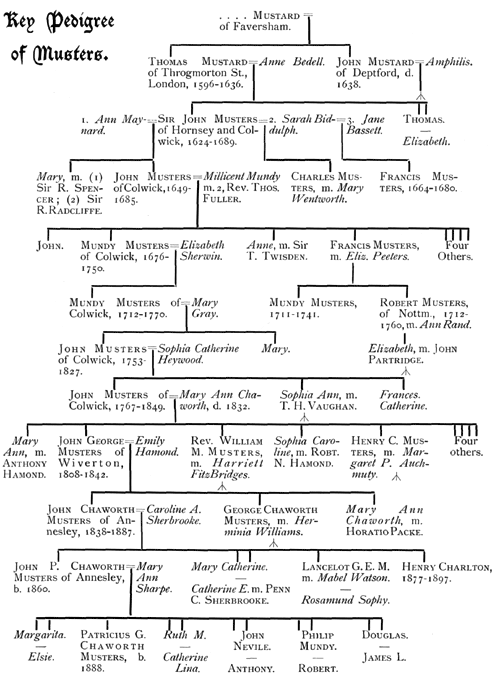
JOHN PATRICIUS CHAWORTH-MUSTERS of Annesley Park; born at Oxton 13 January 1860, and was baptized 11 March. Matriculated at Christ Church, Oxford, 25 January 1878, aged 18. Assumed by Royal licence the name and arms of Chavvorth 6 March 1888. J.P. and D.L. for Notts; Sheriff of Notts 1902. He married Mary Anne, daughter of George Sharpe, and has issue seven sons and four daughters, particulars of whom are given in place on p. 203.
RESIDENCE: Annesley Park, Notts. CLUB: Carlton.
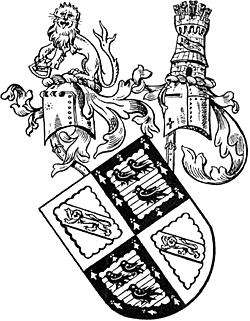
ARMS recorded at Heralds' College: Quarterly—1st and 4th, argent, on a bend gules a lion passant guardant or, within a bordure engrailed of the second, for MUSTERS ; 2nd and 3rd, Barry of ten argent and gules, three martlets, two and one, sable, within a bordure engrailed ermines, for CHAWORTH.
CRESTS: I. A lion sejant guardant or, supporting with the forepavvs a shield of the arms for MUSTERS. 2. A tower argent, charged with a bendlet wavy gules thereon a lion passant or, issuant from the battlement, an ostrich feather sable between four others argent, for CHAWORTH.
ANCESTRY—The surname of this family has been spelt as Musters since the time of Sir John Musters. His father and uncle both followed the spelling Mustard, but about 1636 Mrs. Amphilis Mustard adopted the form Mustard alias Mustars. Whether this family was descended from the ancient Nottinghamshire family of Musters has not been definitely ascertained. It may be that Mustard was a hardened form of the original surname, and that Sir John Musters adopted the earlier spelling in consequence of Camden's opinion that he descended from the family de Monasteriis. However that may be, the surname Mustard was in existence in London about one hundred and fifty years before his time. The will of John Mustard, clerk, of St. Lawrence Pountney, with possessions in Dorset, was recorded in 1480, and we find the will of John Mostard of Owbourne, presumably Wooburn, Bucks, proved in 1506.
This family of Musters, like many another, traces its origin to the commercial enterprise of the merchants in the city of London. Their ancestor, Thomas Mustard, came from Faversham in Kent,* and settled as a merchant in the city, trading with Turkey, and amassed a considerable fortune, and with him we commence the pedigree as below. His eldest son Sir John Musters, "according to Mr. Camden" who died in 1623, so the monument in Colwick Church tells us, was descended from the ancient family of de Monastery's in Yorkshire, though his parentage is not recorded upon the tablet in question. A family of Musters or Mustiers, latinized as de Monasteriis, was settled at Tresvvell, and possessed land there and in other parts of Nottinghamshire. Of this family, which was of knightly rank, Thoroton gives a pedigree of seven generations, under Treswell, tracing them from Robert de Musters, who appears in Doomsday Book as the man of Earl Alan. In the reign of Edward III, 1348-9, Sir John de Musters of Treswell owned property in Sibthorpe, which had descended to him from his ancestor, John de Musters, living temp. Richard I. In the neighbouring parish of Sireston, in the reign of John, 1204-5, Geoffrey de Mustiers held the Richmond fee, which continued in his family till the middle of the following century, when Joan the daughter and heir of Henry Musters of Sireston, carried it to her husband, John de Sutton of Averham, who died in 1369. From the Nottinghamshire Visitation of 1634, it appears that the Sireston branch of Musters bore for arms:—Argent, a bend, within a bordure engrailed, gules. As these same arms, with the addition only of a lion passant guardant, were granted in 1680 to Sir John Musters of Hornsey, it may be presumed that Sir William Dugdale, Garter King of Arms, had satisfied himself that there was a probable, if not a proven, descent from the older Nottinghamshire family. The statement ascribed to the learned Camden that the Musters family came from Yorkshire, where are many instances of the name, and Sir John Musters's ownership of property at Killarby, in the north of that county, may suggest a settlement there of some cadet branch of the Nottinghamshire family, from which Sir John may have descended, although the only positive record evidence so far discovered points to a Kentish origin. Hitherto there has been no adequate inquiry into the early history of this family, and all the printed pedigrees have started with Sir John Musters of Hornsey, the purchaser of Colwick, but researches recently made show that he was the eldest son of Thomas Mustard of Throgmorton Street, in the city of London, gentleman.
I. THOMAS MUSTARD of Throgmorton Street, London, next the Royal Exchange, variously described as "grocer" or "gentleman", was born about the year 1596, as he tells us, in Faversham, Kent. The exact date of his birth and his parentage are alike unknown, but as his eldest son was but twelve at his death, we may conclude that he died a comparatively young man, as his company record would indicate.
He was a member of the Grocers' Company, having been apprenticed to one Robert Cocks, and he mentions in his will his late mistress, Mistress Mary Cocks, widow, elsewhere describing her as "my good mother". He was admitted to the freedom of the Company in 1617, was elected on to the livery 9 May 1618, and became a member of the Court 26 July 1632. He refers in his will to his visit to Turkey, and as he also mentions the East India Company, we may conclude that he at least traded with the far East. Though he names many relatives, his brothers, sisters, aunts, and cousins, we find no reference to the north, and he does not give his father's name. His allusion to his brother and sister Thorold is of interest, having regard to the fact that Sir John Musters's grandson, Mundy Musters, married a niece of Sir Charles Thorold, a London alderman.
He liberally provided for his family, and gave large gifts to charitable purposes, benefiting his Company of the Grocers, bestowing a £100 on St. Catherine's College, Cambridge, and providing an endowment for the poor in his native town of Faversham.
His will, dated 10 July 1634, and proved, P.C.C. 58 Pile, n May 1636, was of considerable length, and in view of its interest a brief abstract follows. It will be seen that he gives legacies to many relatives, and, doubtless, their names would help to increase our knowledge of the family in any extended search into its history.
Thomas Mustard of London, marchant, and free of the Company of Grocers; dated 10 July 1634. To wife Anne, third part of estate. To children, John Mustard, Thomas Mustard, and Elizabeth Mustard, third part of estate, with reversion to survivors. To late mistress, Mistress Mary Cocks, widow. To Company of Grocers, two nests of beare bolles of silver** to the value of twentie pounds, little more or lesse, with the company's armes on them, and written on them to be "the guift of Thomas Mustard, grocer". To aunt Sedger and aunt Thurston, my father's two sisters, twenty pounds apiece. To their children living (not named), and to aunt Thurston a like amount, "if she be liveing at the tyme of my decease". To brother, Mr. John Mustard, £500, and his children (not named), £400. To Sir James Cambell. To Sir Morris Abbott. To Mr. Henry Garway. "Item, Whereas my father did give mee three houses in the Towne of Feversham in Kent, where I was borne, and the said three houses I did give unto my brother, John Mustard, after my comeing out of Torkey, I now desire my said brother to make over unto the maior of the said towne, together with such other persons as the maior and jurats for the tyme being shall thinke meete, those three houses for the use of the poore of that towne . . . and in liewe of the said houses, I give and bequeath unto my said brother the sum of one hundred pounds." The rent of these houses was to provide a sum of two shillings and sixpence weekly to buy bread to be distributed to the poor on Sundays or Fridays at Morning Prayer in the parish church. In the event of the testator's brother not complying with this wish, the testator left a sum of £130to establish the gift in some other way. To the parson of the parish of St. Bartholomew's, by the Exchange, London, where the testator then lived, a bequest of £10 and other sums. Testator desired to be buried in the parish church of St. Bartholomew's, by the Exchange. To friend, Mr. William Spursto, a piece of plate, etc. For increase of the building of Catharine Hall, Cambridge, £100. To Mr. Thomas Boylson, a piece of plate. To Robert Cobley, "my drawer", and his wife (not named), mourning. To godson, Mathew Cobly, £10. "Item, Whereas the worshipful] Company of Grocers owe me moneys lent them for provision of corne, I doe give and bequeath the same unto the seaven poore almesmen in the Hall yard of the said company, parte and parte alike." To Clerk of the Company of Grocers, Beadle of the Company of Grocers, Beadle of the Turkey Company, Beadle of the East India Company, Beadle of the Ward of Broad Street, money for mourning. Sums for mourning to the following:—"My good mother", Mistress Mary Cocks, widow; brother John and his wife and children (not named); father and mother Bedell; brother and sister Thorold; brother and sister Abery; brother and sister Hatrey; brothers Mathew and Thomas Bedell; sister Martha Bedell; cosen Richard Piggott and his wife (not named); cosen John Clarke and his wife (not named); cosen Moore in Canterbury to be sent "her"downe; cosen Mr. John Nutt, near Canterbury, and his wife (not named); cosen John Nutt, in Sussex, and his wife (not named); cosen Mr. William Nutt and his wife (not named); cosen George Nutt and his wife (not named); cosen Mr. Keniston and his wife (not named). To son, John Mustard, house in Throgmorton Street, London, "wherein I now dwell," and three thousand pounds in money at his age of twenty-one years. To son, Thomas Mustard, house and tenements in Croydon, Surrey, "being coppyhould held of the Archbishop of Canterbury, and discends to the youngest son, by the custom of the mannor"; and a thousand pounds in money at his age of twenty-one years. To daughter, Elizabeth Mustard, a sum of one thousand pounds, at the age of twenty-one years or day of marriage, with reversion to survivors. Executors, sons John and Thomas, but during their minority executorship placed in the hands of father-in-law, Mr. Mathew Bedell, and brother John. Witnesses, Geo. Allestry, scrivener; Tho. Bostock, scrivener; John Langham, and Martyn Dallyson. Will proved by John Mustard, brother of deceased, 11 May 1636.
After his death an inquisition was taken as to his real property.
Inquisition taken at the Guildhall, London, 22 April, 12 Charles [1636], after the death of Thomas Mustard, gentleman. The jurors say that he was seized of a capital messuage in Throgmorton Street, Lothbury, London, late in the occupation of William Walmesley, gent., and then of the said Thomas Mustard, and formerly belonging to the Priory of St. Mary Grace, next the Tower of London, and granted by King Henry VIII to Hugh Losse and Thomas Bocher. By his will, dated 10 July 1634, Thomas Mustard devized the same to his son John Mustard. Thomas Mustard died 30 March last [1636]. John Mustard, his son and next heir, was then aged 12 y. 3 m. 21 d. Anne Mustard, his widow, survives, and is dowable out of the said messuage.
He married Anne, daughter of Matthew Bedell, but nothing is known of that family. She unhappily became insane in April 1630, and on her husband's death it became needful to hold an inquiry thereon. An abstract of this document is as follows :—
Inquisition de lunalica inquirenda taken at the Guildhall, London, 22 April [1636]. The jurors say that Anne Mustard of Throgmorton Street, London, became lunatic in April, 6 Charles [1630]. That she is possessed of goods and chattels worth £813s. 4d., and other goods worth £30 9s. 2d., which came to her on the death of her late husband, Thomas Mustard, gentleman. That Thomas Mustard made his will 10 July 1634 as follows, inter alia: "I give and bequeathe unto my loving wife, Anne Mustarde, one third part of my estate according to the custom of the city of London, and I pray God send her health to enjoy it, and it is not for want of love to her that I express not myself further, but in regard to her present infirmity I forbear to make any further addition." That Thomas Mustard died 10 March last [1636], at Lothbury, and that she is seized by way of dower of one third part of the tenement in Throgmorton Street, next the Royal Exchange, and the said one third part is worth £15. John Mustard, gentleman, is her son and next heir, and is now aged 12y. 3m. 13d. See last inquisition which shows a discrepancy of one month in the age.
Attached to this last inquisition are two schedules, the first of which we give in full, as showing the furniture of a lady of wealth living in the city of London in the reign of Charles I. Of the second and larger schedule, which gives minute particulars of her wardrobe, we must content ourselves with the first and last items.
A schedule of the goods of Mrs. Anne Mustard, widdowe, wch remaine in her chamber over the kitchen in her house in Throgmorton Streete, London, made this xxijth day of Aprill, Anno Dni. 1636:—
|
£ |
s. |
d. |
Imprimis, a feild bedsted matt and cord testerne vallance and curtein'es of greene saie, three curteine rodds, and a co'te cupboarde |
04 |
00 |
00 |
Item, a fether bedde and boulster, twoe pillowes, one blankett, one olde quilte, a redd rugge, and one greene cradle rugge |
03 |
06 |
08 |
Item, one elbowe chaire of greene cloth fringed, and twoe purled lowe stooles |
00 |
06 |
08 |
Item, the Queenes armes in a frame and a picture |
00 |
05 |
00 |
Item, the hangings of Dornex about the roome, a windowe curteine of the same and curteine rodde, and the fire irons in the chimney |
00 |
15 |
00 |
Summa totalis |
8 |
13 |
4 |
The second schedule bears the same date :— |
|
|
|
|
£ |
s. |
d. |
Imprimis, one goune of velvett grogram wth kirtle and stomacher of ye same |
03 |
00 |
00 |
[Other numerous items follow.] |
|
|
|
Item, one weddinge ringeof gold weighinge Sd. weight and 16 graines |
01 |
04 |
00 |
|
30 |
09 |
2 |
Her brother-in-law, John Musters, was appointed her guardian, and David Ramsay became, on 21 Nov. 1636, trustee of her property, the income of which was to be expended for her benefit. The date of her death has not been ascertained. Some further particulars of Thomas Mustard will be found in the Chancery proceedings relating to the administration of his estate in 1639. See Notes, p. 204.
Thomas Mustard and Anne Bedell left three children :—
i. JOHN MUSTERS, of whom next, ii. THOMAS MUSTARD. iii. Elizabeth.
Of the two younger children nothing further is known than what we learn from their father's will. [But see footnote, page 204, post.]
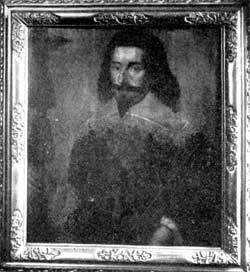
Sir John Musters (1624-1689).
II. SIR JOHN MUSTERS of Tower Place, Hornsey, Middlesex, and of Colwick, was born either 11 Dec. 1623, or 11 Jan. 1624, but his birthplace is not known. He was knighted at Whitehall 2 June 1662, and died at Hornsey, Sunday, 28 July 1689, aged 66, and was buried at Colwick, where there is a tablet with bust to his memory.
His father's will shows that Sir John Musters inherited wealth, and he bought Colwick from Sir James Stonehouse, bart., 5 July 1648, for £18,000. On 3 Nov. 1668 he acquired Tower Place, with twenty-one acres of ground in Hornsey, from John and Joseph Chambers, the sons of Richard Chambers, esq. At the Court Baron of Hornsey, held 9 May 1690, it was found that Sir John Musters had died seized of Tower Place, and that his grandsons, Mundy, Thomas, Charles, and Francis Musters, all under age, were his heirs, from which it may be inferred that the custom of gavelkind prevailed in that manor. As her children's guardian, Millicent Musters, widow, on 5 June 1690, leased Tower Place to Sir John's widow, Lady Jane Musters. This house, in the great storm of 1703, was so much damaged that by leave of the Bishop of London it was shortly after demolished, and it appears to have passed out of the possession of the Musters family in 1704, when it was surrendered by Francis Musters to one Thomas Joyner.
Sir John Musters was elected a governor of Highgate Grammar School 18 April 1675. In 1680 he obtained a grant of arms from Sir William Dugdale, Garter King of Arms. In 1684 he rebuilt the chancel of Col wick church, which he repaired. He evidently was a man of wide sympathy, for it is recorded of him that he befriended some nonconformist ministers who were in trouble with the authorities. It seems likely that these were the Rev. William Reynolds, lecturer at St. Mary's, and the Rev. John Barrett, rector of St. Peter's, who, in 1660, were indicted for not using the Common Prayer of the Church, and some time after were arrested at a meeting-house at Colwick. As Sir John Musters married a daughter of the distinguished "covenanter", Sir John Maynard, it may be presumed that he was interested in the Presbyterian party. Sir John Musters appears to have lent money upon the security of Bestwood Park, for the Secret Service Expenses of Charles II and James II, p. 167, states that £3,774 12s. 6d. was paid to Sir Robert Clayton, a London alderman, for redeeming the mortgage to Sir John Musters of Bestwood Park, and for settling the same for life upon Mrs. Eleanor Gwynn, and after her death, upon the Duke of St. Albans, with reversion to the Crown. Besides his estates at Hornsey and Colwick, Sir John had property at Killarby, in Catarick, Yorkshire. His will, which was proved by his son, Charles Musters, with two codicils, 31 July 1689, in the P.C.C., is as follows:—
Sir John Musters, knight, of Hornesey, Middx., dated 1 Sept. 1687, 3 James II. To be buried in the parish church of Collwick. To his wife £100, rings, jewels, etc., coach and pair of coach horses, and an annuity of £60 charged on land at Killarby, parish of Cattarick, Yorkshire, also use of so much plate and house stuff as she shall have occasion for. Residue of plate, etc., to his daughter-in-law, Mrs. Millicent Musters, in trust for her son, Mundy Musters. To Mrs. Millicent Musters, £50. To his 3 grandsons, Thomas, Charles, and Francis Musters, £400 each, at 21. To his two granddaughters, Anne and Millicent Musters, £1,000 each, at age of 18. To his daughter Spencer, £100. To his son, Charles Musters, the manor of Killarby, par. Kattarick, subject to the annuity to his widow. To the poor of Hornesey, £5. To Mr. Stokes, the minister of Collwick, £5. To all his household servants, 40s. each. Residue to his son, Charles Musters, the sole executor. Signed, J. Musters. Witnesses, Triamor Baldwin, Stephen Locker, Hugh Price, all servants to Sir Robert Clayton, knt.
Sir John Musters married (i) Anne, daughter of Sir John Maynard, K.B., of Tooting, Surrey, a distinguished politician under the Commonwealth. [See Notes p. 204.] The date of her marriage and death has not yet been ascertained. Sir John Musters and Anne Maynard had issue:—
i. JOHN MUSTERS of Colwick, born 1649, of whom next.
ii. Mary, born in Petty France, Westminster, Wednesday, 24 Aug. 1651, who d. 3 Sept. 1719. Her will, dated 19 May, was pro. 18 Sept. 1719. Mar. (i) at Hornsey, 23 July 1672, Sir RICHARD SPENCER of Offley, Hertfordshire, bart., who d. 21 Feb., and was bur. 23 Feb. 1687-8, aged 41, leaving issue. Lady Spencer mar. (2) 25 April 1691 (settlement 22 April), Sir RALPH RADCLIFFE of Hitchin, Herts, krit., whose will, dated 3 Feb. 1713-14, was proved 29 July 1720. Now represented by the family of Delme Radcliffe. Some extracts from her Diary now in the possession of Mrs. Musters, of Wiverton, are given in the Notes.
Sir John Musters married (2) at St. Antholin's, Budge Row, London, 25 April 1654, Sarah, daughter of Anthony Biddulph. No further particulars of her have been noted, but her father's name would indicate a descent from the Biddulphs of Elmhurst, from which family came the Biddulphs of Ledbury, now represented by Lord Biddulph. It is probable that Anthony Biddulph was son of Simon Biddulph, of Elmhurst, and Joyce Floyer, of Uttoxeter, and uncle of Sir Theophilus Biddulph, created a baronet in 1664, who was a trustee of the Colwick estate. Sir John Musters and Sarah Biddulph had issue:—
iii. CHARLES MUSTERS of Great Russell Street, London, and of Ugley, Essex, esquire, born 4 Feb. 1654-5 in Charter House Square; died 18 Dec. 1719, aged 64, s.p., and was bur. at Colwick. He matriculated at Christ's College, Cambridge, 16 Jan. 1670-1, and left 24 Nov. 1673. Admitted to the Inner Temple 14 June 1673, sworn 28 Nov. 167-. Under his father's will, of which he was executor, he acquired Killarby, in Yorkshire, which he left to his niece, Millicent Musters (Mrs. Scott).
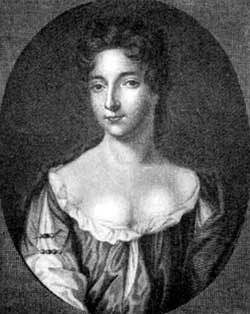
Mrs. Charles Musters, Mary Wentworth.
He mar. 20 Feb. 1687-8, in King Henry VII's Chapel, Westminster Abbey, Mary, daughter and heir of John Wentworth of Somerleyton, by his second wife Dorothy, daughter of Sir Thomas Leventhorpe, second bart., of Sawbridgeworth, Herts. She died and was bur. at Sawbridgeworth. Will dated 13 April 1742, proved 12 Oct. 1749. Of this lady there is an engraved portrait, here reproduced.
Sir John Musters married (3) Jane, daughter of Sir Francis Bassett, knight, of Tehidy, Cornwall, by licence, she being then of St. Dunstan's-in-the-West, London, with consent of her mother, Dame Anne Bassett, widow, to be married at St. Bartholomew the Great. Lady Musters, who survived her husband, resided at Tower Place, Hornsey, died 17 Sept. 1691, aged 67, and was buried at Hornsey, m.i. there. Will dated 14 Sept. 1691, proved 8 Oct. 1691, by her sister, Dame Elizabeth Keling, widow of Sir John Keling, Lord Chief Justice of the King's Bench. Sir John Musters and Jane Bassett had issue:—
iv. FRANCIS MUSTERS, born at Hornsey 1 May 1664; d. at Hornsey, of the small pox, 16 April 1680, and was bur. there, m.i. there.
* It will be seen from the Canterbury Marriage Licences, see p. 205 post, that the Mustards were well established in Kent in the sixteenth and seventeenth centuries.
** These were destroyed in the great fire in 1666.
